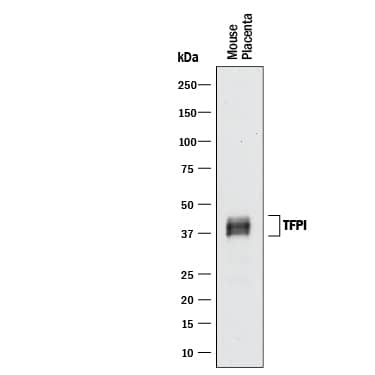Mouse TFPI Antibody
R&D Systems, part of Bio-Techne | Catalog # AF2975

Key Product Details
Species Reactivity
Applications
Label
Antibody Source
Product Specifications
Immunogen
Leu29-Lys289
Accession # O54819
Specificity
Clonality
Host
Isotype
Scientific Data Images for Mouse TFPI Antibody
Detection of TFPI by Western Blot.
Western blot shows lysate of mouse placenta tissue. PVDF membrane was probed with 2 µg/mL of Goat Anti-Mouse TFPI Antigen Affinity-purified Polyclonal Antibody (Catalog # AF2975) followed by HRP-conjugated Anti-Goat IgG Secondary Antibody (Catalog # HAF017). A specific band was detected for TFPI at approximately 37-42 kDa (as indicated). This experiment was conducted under reducing conditions and using Immunoblot Buffer Group 1.Detection of Mouse TFPI by Simple WesternTM.
Simple Western lane view shows lysates of mouse placenta tissue, loaded at 0.2 mg/mL. A specific band was detected for TFPI at approximately 50-60 kDa (as indicated) using 100 µg/mL of Goat Anti-Mouse TFPI Antigen Affinity-purified Polyclonal Antibody (Catalog # AF2975) followed by 1:50 dilution of HRP-conjugated Anti-Goat IgG Secondary Antibody (Catalog # HAF109). This experiment was conducted under reducing conditions and using the 12-230 kDa separation system.Applications for Mouse TFPI Antibody
Immunoprecipitation
Sample: Conditioned cell culture medium spiked with Recombinant Mouse TFPI (Catalog # 2975-PI), see our available Western blot detection antibodies
Simple Western
Sample: Mouse placenta tissue
Western Blot
Sample: Mouse placenta tissue
Formulation, Preparation, and Storage
Purification
Reconstitution
Formulation
Shipping
Stability & Storage
- 12 months from date of receipt, -20 to -70 °C as supplied.
- 1 month, 2 to 8 °C under sterile conditions after reconstitution.
- 6 months, -20 to -70 °C under sterile conditions after reconstitution.
Background: TFPI
Tissue Factor Pathway Inhibitor (TFPI), also known as lipoprotein-associated coagulation inhibitor (LACI) and extrinsic pathway inhibitor (EPI), is a physiological inhibitor of extrinsic pathway of coagulation and has biological functions of anticoagulation and anti-inflammation (1). It is a secreted protein with an N-terminal acidic region, three Kunitz (K) domains separated by two linker regions, and a C-terminal basic region (2). The first K domain (residues 50-100) inhibits coagulation factor VIIa complexed to tissue factor (TF). The second K domain (residues 121-171) inhibits factor Xa. The third K domain (residues 225-275) binds to heparin (3). The C-terminal basic region may have several functions. For example, it plays an important role in the binding of TFPI to cell surfaces (2). The purified recombinant mouse TFPI ends at residue 289 and does not contain the last 17 residues (residues 290-306) in the C-terminal region. It inhibits the activity of recombinant human Coagulation Factor VII (R&D Systems, Catalog # 2338-SE) in the presence of recombinant human Tissue Factor (Catalog # http://www.rndsystems.com/product_results.aspx?k=2339-PA">2339-PA) .
References
- Bai, H. et al. (2005) Thromb Haemost. 93:1055.
- Bajaj, M.S. et al. (2001) Thromb Haemost. 86:959.
- Mine, S. et al. (2002) Biochemistry 41:78.
Long Name
Alternate Names
Gene Symbol
UniProt
Additional TFPI Products
Product Documents for Mouse TFPI Antibody
Product Specific Notices for Mouse TFPI Antibody
For research use only

